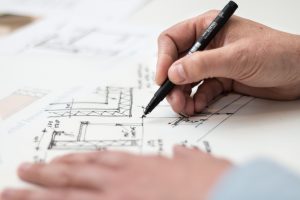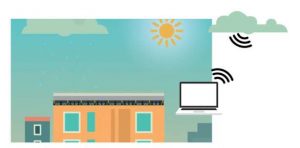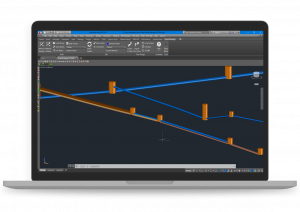It’s been a really big year in drainage design and next year is shaping up to be just as exciting.
Following our visit to the fantastic Flood Expo in Birmingham last September and as part of our mission to spread the word about the wonders of smart, sustainable drainage, we’ve brought you a summary of where we think the industry might be heading over the next 12 months.
We’ll be exploring upcoming developments as well as predicting some interesting trends, including improved monitoring measures, increased reliance on SuDS, and new software that could completely change how our systems react to extreme events.
So, let’s get started…
Prediction 1: More information required to get through planning!
One of the more frustrating elements of water management is that historically, it’s always been difficult to monitor and maintain our drainage systems.
Even predominantly accessible, above-ground solutions like SuDS have some functionality issues that can make it difficult to keep an eye on. When combined with the fact that the majority of our drainage systems in the UK still rely on large, underground tanks as attenuation strategies a clear problem is starting to become apparent.
In addition, for general water management, we’re still in the habit of following the traditional practice of transporting water off-site as quickly as possible via a complex network of underground pipes.
These systems work well when the country is experiencing average rainfall. However, as soon as we experience extreme events these solutions can quickly be compromised, potentially increasing the flood risk downstream.
Considering how Climate Change is affecting our planet, it should come as no surprise to learn that this kind of weather threat isn’t going away any time soon. Factors like global warming and increased urbanisation mean that flood risk is at an all-time high, bringing it more to the attention of our local planners and key decision makers.
As a result, we are already seeing a major shift in what evidence we are being asked to provide as part of planning applications and, as we start to experience more extreme weather. It is likely that these requirements are going to increase over this coming year.
Figure 1: Planning Application

Prediction 2: More research into SuDS and an increased demand for their use to reduce a developing sites carbon footprint
If you’ve been following us on social media or via this blog, you will probably now be well acquainted with the concept of Sustainable Drainage Systems (SuDS).
While it’s certainly not a new idea, SuDS is likely to become an even hotter topic in 2022 thanks to events like #COP26 bringing it mainstream and the global push to reduce our carbon footprint.
In addition, from next year onwards, developers, architects and many engineering professionals will likely be seeking new techniques and approaches to ensure their projects (or their client’s projects) adhere to new carbon offset measures.
For anyone new to the topic, SuDS involve a range of predominantly above-ground drainage techniques that aim to mimic the natural run off profile of a site. Some benefits of these types of systems are widely acknowledged, such as how they can improve water quality and promote biodiversity. What is less widely known, however, is that the use of SuDS, can also provide a great opportunity to reduce the carbon footprint of our drainage schemes, particularly where the greener methods at the top of the SuDS hierarchy are implemented.
Figure 2: Example SuDS Scheme

Source: www.ciria.org
Rennard Consulting are therefore looking forward to more innovation and developments around the concepts of SuDS being explored over this coming year, with one potential hot topic being the retrofitting of SuDS to mitigate flood risk, improve our living and working spaces, as well as potentially being our secret weapon to reduce the the amount of sewerage discharging into our rivers and seas.
Prediction 3: Linking drainage networks to live weather data
Now we all know that traditionally, drainage engineers have been exceptional at burying their work under the ground. The issue with this historical approach is that it makes it a lot harder to tell when our systems are failing or which mitigation measures we may need to take. Often, the earliest warning sign we have that something is wrong is when water starts bursting out of manholes – that is until now.
It may come as no surprise that it has always been easier to prevent a disaster than to try to resolve it and there seems to have been a real development recently in monitoring techniques in water management. In short, drainage is starting to get smart, with Engineers beginning to use a combination of up to the minute data and intelligent prediction models to take preventative action.
Next year, we expect to see more insight into how linking up drainage networks to live weather data can prevent or even mitigate major flooding incidents.
The plan involves installing more advanced monitoring hardware inside our existing and proposed drainage networks. Using this technology, the industry will be able to collect live data on factors such as water levels and volumes, before linking it up with current meteorological data and insight from weather prediction models.
Forearmed with the knowledge of an incoming storm, for example, drainage and water management engineers will be able to adjust drainage networks to attenuate storm water more effectively.
Some of this technology involves intelligent automation. For example, Polysnyc, developed by the guys at Polypipe, is a smart surface water tool that can adjust water volumes stored in attenuation tanks according to live weather data.
Figure 3: Polysync

Source: https://www.polypipe.com/polysync
Some companies are also stating to explore technologies that can help us remotely monitor water levels within manholes (particularly those in areas where there’s a significant risk of flooding) to better predict when they’re going to pop and help us tackle the more challenging surface water flooding issues.
We at Rennard Consulting believe that monitoring our existing and proposed networks could become a major factor in future builds, especially if it can help to counteract the effects of flooding in our existing sewer system.
Prediction 4: Drainage design software updates for 2022
There are some potential exciting software developments in the world of drainage design in 2022.
The first relates to one of the sectors most crucial software providers, Innovyze. They offer a suite of design and modelling software programs, such as Microdrainage, which help engineers create innovative, high quality drainage systems.
In the spring of 2021, it was announced that Innovyze was being acquired by global software leader, Autodesk. It seems that the tech giants want to help address challenges facing the global water infrastructure by supporting Innovyze and the software it provides to technicians and engineers all over the world.
Rennard Consulting are very excited to see how Autodesk’s support positively impacts the software and programs that Innovyze provides to its clients and how it could potentially make it much smoother getting hydraulic designs converted to drawings and BIM models.
Speaking of drainage design software; a new provider has also recently waded into the market. Causeway offers an end-to-end drainage design solution that enables engineers to design optimal and UK-compliant drainage systems.
Figure 4: Extract from Causeway Model

Source: https://www.causeway.com/products/drainage-design
It is already being used by a number of consultants and we are looking forward to seeing how Causeways cloud-based software will be helping drainage engineers create new solutions in 2022.
Summary
So in conclusion, while I’m sure we would all love a crystal ball to predict the future this currently is not available, and while we have discussed our top predictions for this coming year, nothing is for certain. Whatever the future holds however, we are sure 2022 is going to be an extremely exciting time for the water industry as we all rise to meet the new challenges posed by the onset of climate change that are sure will lead to more innovative solutions being developed across the sector.
There has never been a better time to explore your drainage options. So why not make it your New Years Resolution to get in touch or check out some of our other blogs for more insights into smart, cost-efficient, planet-saving drainage design?